Abstract
Digital media technology has changed the visual expression and information dissemination mode of traditional display space, and the concept of exhibition art is gradually changing to diversification and conceptualization. However, the application of digital media technology in China is in the initial development stage, and how to better combine digital media technology with display design has become an urgent problem to be solved. Based on the comparative analysis of excellent cases of immersive digital display space at home and abroad, this paper proposes that China should innovate in design concept, interactive form and space design to build better visiting experience in view of the existing problems of immersive digital display space in China. By using the theory of media environment, the paper analysed the essential characteristics and trends of digital display media environment, and deeply probes into the design methods and latest technologies of immersive digital display projects. It aims to found a reasonable and innovative design method to deal with the interactive change brought by digital display media, in order to achieve efficient cultural communication effect by using digital technology.
Keywords: Display design, immersive experience, Media Ecology, interaction design, cultural diffusion
Introduction
In the era of digital communication, the communication mode of exhibition space has got rid of the limitation of space and time, and moved towards the communication at the level of spirit and experience. With the development of science and technology, the emergence of immersive exhibition space in the new media environment further reconstructs the perception model of visitors, enabling people to participate in person and have better experience by interaction. The information dissemination of immersive exhibition space is not only the dissemination of display content, but also the dissemination of interactive innovation forms and innovative experience modes. Advanced science and technology provides the exhibition space innovation with appropriate technologies, which bring designers such important research topics as using the emerging technologies to design exhibition space , exploring the design strategy of creating deep immersion in the design of exhibition space, establishing the connection between culture and audience, realizing multi-level and diversified interpretation of culture, and helping the exhibition space to achieve efficient dissemination of culture.
Problem Statement
The unique display content is the key factor to reflect the level of display, and also an important factor that can stimulate the audience's desire to visit. If we just focus on the form of the display with the content being ignored or give free rein to the exhibition company, the display effect will have some problems, such as the display theme is not clear, the display content level is chaotic, the display space layout is unreasonable, the performance line is not smooth, the communication effect is not satisfactory and so on. Some museums even copied the multimedia designs from each other. Although advanced new media technology is used, the simple listing of the exhibition contents and the introduction of information in a straightforward manner will make the audience feel bored, and a quick and brief tour will make they lose interest easily in the exhibition.
In order to attract the audience, abuse of new media means in the display to create amazing eye-catching visual effects is nothing new. A commercial displaying a spaceship on the big screen with glasses-free 3D technology made a sensation recently. The image looks gorgeous, but it lacks cultural connation. Therefore, the audience are unable to acquire relevant corporate culture after watching and do not have communication with the display in a perceptual mode. Immersive digital display design should be innovative in expression of cultural creativity, and use digital technology to disseminate excellent culture in an appropriate way of expression.
The single interactive structure makes the audience unable to participate in the exhibition and interact with the exhibits. Take an expo pavilion for example. The architectural external and internal design of it embodies the good intentions of the team. Although digital media is used to assist the exhibition, the audience can only feel the Chinese food culture visually according to the specific exhibition route, resulting in a state of passive receiving of information, and interaction with the audience is missing.
Research Questions
- How to combine digital media technology with display design?
- What are the advantages of digital media in the exhibition space?
- What theoretical support does Media Ecology provide for digital display space?
Purpose of the Study
The purpose of the study is to find a reasonable and innovative design method to deal with the interactive changes brought by digital display media in order to use digital technology to achieve efficient cultural dissemination effect.
Research Methods
This paper was based on the theory of Media Ecology, digital display as the research object, and analysis the essential characteristics and influence of digital display media environment, deeply explored the design elements of immersive digital display points. According to the method of keyword topic classification, the relevant literature at home and abroad was studied and analysis. And contrasted and analysis excellent cases of immersive digital exhibition space at home and abroad.
Findings
Different from the traditional display with limited content and single interactive form, modern immersive display has the advantages of rich display content and diversified interactive ways. Immersive experience space design makes full use of entity space for information dissemination. VR, 5G and other technologies can store unlimited display information, and the display content is no longer limited by time and space. In the immersive environment created by digital display, the audience deeply experiences and participates in the interaction, generating a two-way communication. At the same time, the interest of digital display can guide the audience to actively participate in the experience, obtain more relevant display extension information, personally feel the pleasure brought by digital technology.
The spiritual demand of human is the ultimate pursuit of the purpose of display, and digital display should better reflect the humanistic spirit. Follow-up studies at the French Museum of Natural History have shown that visitors' memories remain deep and lasting because they are stimulated by multiple senses. As Kenya Hara writes in "Design of Design", "the building materials of the brain come from various sensory organs"(Kenya Hara, 2006). The general scene restoration, video playback and other visual centered mode are not enough to meet the needs of the audience. Modern digital technology display can create a novel visual effect, through mobilizing multi-sensory experience to meet the audience's experience needs for abstract content, and to achieve physical space immersion by showing rich artistic appeal. The best state of human experience is psychological space immersion. The flow model of Csikszentmihalyi, a famous American psychologist, shows that when people's skill level is in a certain balance with the challenges they face, they can produce flow and achieve the most unforgettable experience. Therefore, in the design of exhibition space, we should pay attention to use digital technology to meet the experience needs of a variety of people. The audience can choose according to their individual needs, so that each audience will have their own unique psychological experience, so as to achieve the purpose of widely spreading information.
The application of new media interaction technology in the exhibition space enables information to be disseminated well, and the forms of interaction become more and more abundant with the progress of science and technology. The computer gives real-time feedback to the user through gestures, voice, eye tracking, etc. The audience takes the initiative to explore from the interaction, which reflects the two-way communication of the display information. In the future, the development trend of exhibition media must be "man-machine interaction". Machines can read people's thoughts and promote the transformation and expression of exhibition themes. The descriptive statistics are presented in the Table 1.
Digital cultural communication enriches the theory of Media Ecology
The fundamental purpose of digital display is to disseminate display information more efficiently. As a bridge to disseminate cultural information, the interesting expression of information content can enable the audience to better understand the display content and obtain more display information. As Fischer (2009) said, although the nature of the digital kingdom is technology and binary code, it unleashes the most boundless imagination in all fields of human beings. Digital display is the "catalyst" of cultural communication. As a way of transmitting information, it can meet the audience's aesthetic needs at the sensory level as soon as possible. Digital display, as the medium of transmitting the display content to the audience, not only promotes cultural sharing, but also is the auxiliary means of display design. Digital display depends on digital technology. The development of digital technology improves the speed of information dissemination and expands the scope of information dissemination.
In addition, the significance of the information communication of immersive digital display space is supported by media ecology theory, to a great extent, because the immersive digital display space is developed under the background of the continuous progress of information communication technology. The communication of immersive digital display space is moving towards the information interactive network of innovation, interaction and experience, which subverts the closed, one-way, boring and narcissistic art communication process of traditional display space. In today's electronic media environment, the technological update of communication media has brought people innovative formal experience and provided a platform for diversified understanding and communication (Peng, 2012). At the first screening of "Train Arrives" in Paris, the audience got up and ran in fright to avoid being overrun by a distant train that was about to crash out of the screen. As seen in Figure 1 below, audiences have become accustomed to this medium and even get the psychological experience of visual spectacle by going to the cinema to watch 3D films.
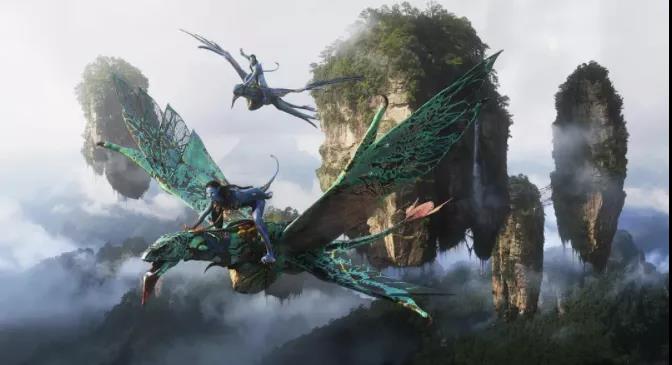
McLuhan believes that "media is the extension of human beings", and digital media extends the scope of human understanding of culture (as cited in McLuhan & Dao, 2000). Paul Levinson, the representative of media environment school, sublating McLuhan's media thought, emphasized that human being is the main body of communication. When using new media technology, people should play a subjective initiative, and think that the evolution of media will show a "humanization trend". The development of media technology is more and more like human, even imitating and copying human perception and cognitive mode (Yu & Shuo, 2019). This theory of "humanization trend" coincides with people's use of new technology to design exhibition space. The development of digital media presents the trend of "humanistic care". The integration of art and technology strengthens the care between people and the relationship between people and things. Carrey writes that when culture is included in communication studies, it becomes the dominant force (Karrie & Wei, 2005). Nowadays, designers should put "caring for people" in the first place in design, focus on the guidance of value, rationally use digital technology to carry spiritual content to design exhibition space, and realize cultural sharing.
Design method and innovation of exhibition space under the guidance of Media Ecology theory
With the continuous progress of science and technology, in order to meet the requirements of exhibition space design under the background of the new era, exhibition space needs to innovate in two aspects of interactive form and space design. "Media ecology school emphasizes the important role of human in the media ecology, and focuses on how to study the relationship between human and media"(Wen, 2007). The essence of exhibition is people's common appeals for culture and spirit, an exhibition hall with humanistic care can arouse the audience's resonance and make the audience immerse in it psychologically. In the exhibition design, we should design the exhibition content from the perspective of paying attention to people's participation and experience, expressing the humanistic connotation of the exhibition theme, and rationally use the new media technology in combination with people's demand for space in order to achieve the purpose of spreading culture.
To solve the problem of simply transferring the display information to the screen in the design of digital display space, the following innovative design methods are proposed:
Create narrative space design and emphasize the role participation of "people"
"When a close connection is formed between space and people, space will have a narrative" (Wang & Lei, 2016). In the design process, we should focus on the purpose of the exhibition to complete some key issues, the narrative should be logical and interesting, and grasp the sense of rhythm.
"Walk, walk, walk home" exhibition transforms the basement into an art space for people to create. As seen in Figure 2 below, the goal of this project is to connect people with the world through "communication" and "creativity". People can use electronic devices to freely create paintings anytime and anywhere. When the works are uploaded to YouTube, they will become life size and walk with other people's painted characters. When the audience touches the characters, they will make corresponding reactions. This exhibition constructed a vivid story space and created a story plot that can empathize with people. Through this case study, designers should pay attention to the following points when designing interactive forms:
- Accurately and efficiently convey the design concept, make full use of the internal relationship between people and exhibits, people and space, space and exhibits, so that the display content can be closely exchanged in the interaction of the three.
- Pursue high technology while taking human feeling into consideration, let people participate in the creation and display, and pay attention to the expression of interestingness.
- Break through the boundary between display device and space, and fully integrate display content and media with narrative design.
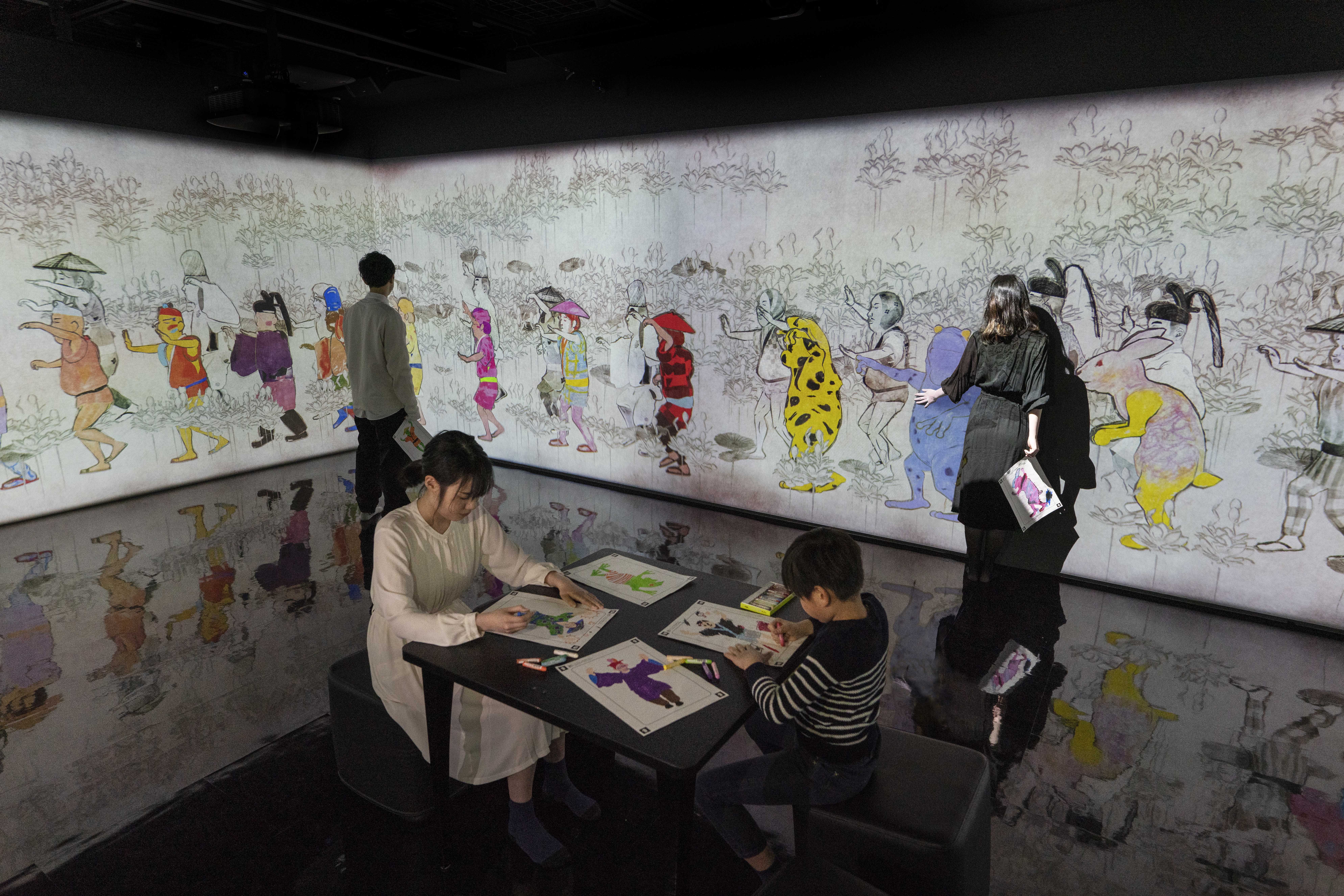
Use digital media technology to impact all senses
Digital technology is the key technical support of multilevel spatial narration. It has a strong impact on the visual sense in the exhibition space, and supports visitors to observe the dynamic images suspended in the space from any place around; real-time video synthesis is uploaded by professional software and combined with the broadcast image, so that people can get timely interactive feedback, which will enhance the "sense of presence" of participation, subvert the concept of time and space, and place the object into a brand new realm; phantom imaging and multi scene conversion use physical model and special lens, and then accurately match with the "spectral vision" processed by computer to form a full range of dynamic vision and immersive feeling, which is suitable for the production of large scenes. With proper choice and full use of multimedia technology, the design of the exhibition space will be more immersive.
Immersive digital display, through holographic spatial imaging, real-time video synthesis, phantom imaging and multi-scene conversion and other technologies, shows the audience the concept of artistic design digital art works. Sound, light, and electricity are employed to create a splendid picture, presenting an audio-visual feast beyond the sense of time and space in the real space. The mutual blending of art and technology promotes the vigorous development of digital media art, and various artistic works with high aesthetics and high innovation are springing up (Ying, 2021). As seen in Figure 3 below, the theme scene " Universe of Water Particles,Transcending Boundaries " uses digital calculations to simulate Water flow, creating a rock where the viewer stands and acting as a barrier to the direction of the flow. The exhibition space is open, with no lighting setting at the top. The new media technology was displayed through walls, floors and columns. Creators let the audience ignore that interactive art exhibition is a technology provided by computer. In the presentation of art, they focus on the interaction between people and people, people and environment (Meng, 2020). The application of digital technology realizes real-time interaction, stimulates the audience's senses from visual, auditory and tactile aspects, and enables the audience to achieve whole-body immersion experience and complete emotional communication. He Jian believes that professional artists create pure art and that only a minority of people have the right to enjoy it (Shen, 2009). Teamlab is a team composed of scientific and technological personnel, artists and so on. It uses scientific and technological means to present art. Each exhibition has a unique design concept. But the works are elitist and can only be appreciated by a certain group of people.
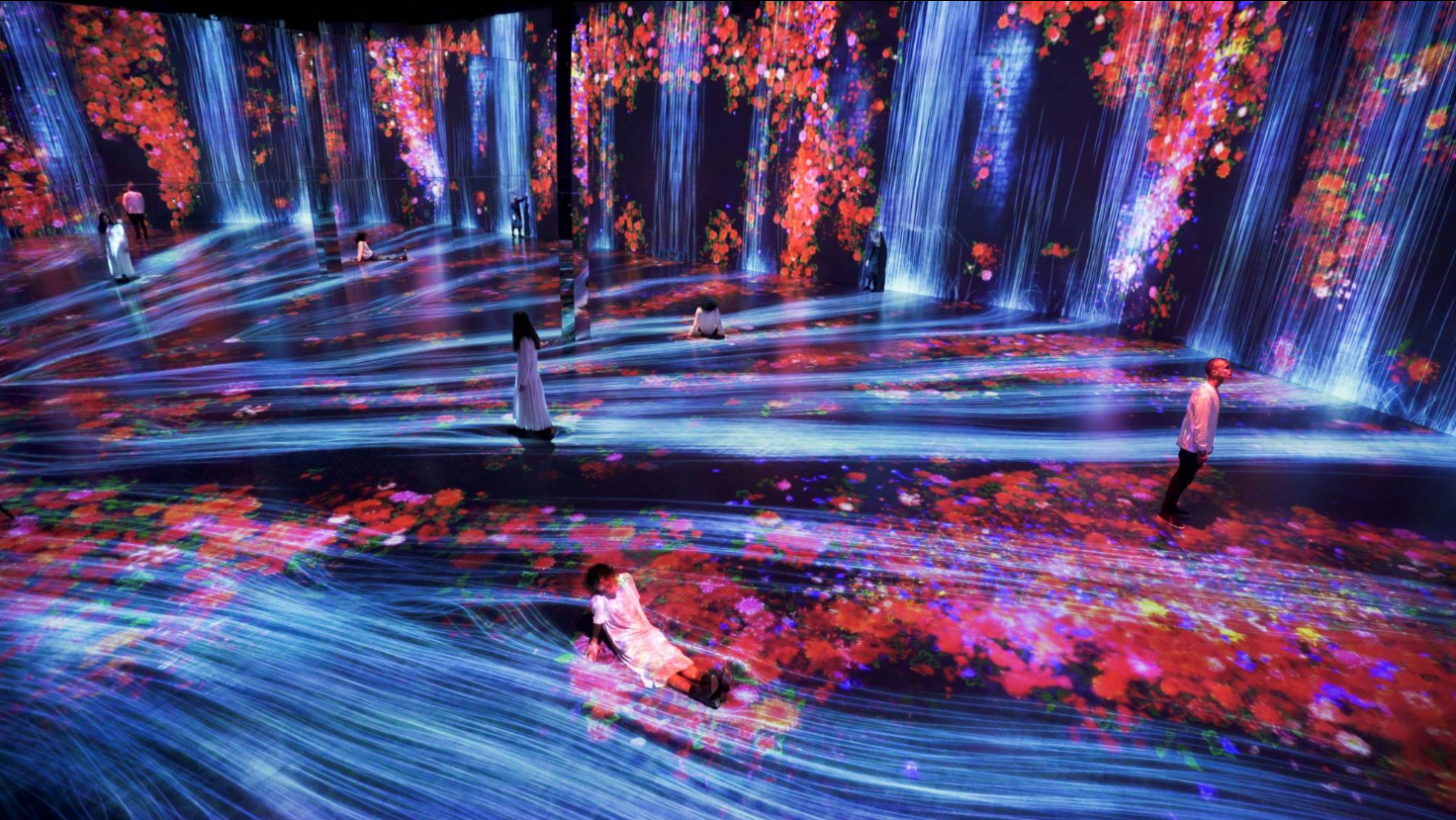
High integration of virtual reality technology and culture
The artistic appeal of spatial plot often comes from the process of the relationship between specific material carrier and life plot in spatial experience, as well as the chain reaction of spatial experience and the participation and interest in the experience (Yan, 2020). The space needs to have the change of starting and turning and the appeal of the space plot to transmit the cultural value.
Immersive display design plays a key role in the protection of cultural heritage (Allam & Jones, 2020). As seen in Figure 4 below, the dance "Tang Palace Banquet" on the Spring Festival Gala of Henan Satellite TV in 2021 integrates "5G+AR" technology, creatively transforming traditional culture and spreading the traditional culture of the prosperous Tang Dynasty. The actors' facial expressions, makeup and clothing conform to the "plump beauty" of the Tang Dynasty, highlighting the cultural customs of the prosperous Tang Dynasty. The augmented reality technology is used for better performance and dissemination of historical culture, so that the audience are better immersed in traditional Chinese culture. At the same time, the innovative application of digital culture and the creation of space scene atmosphere also reflect modernity in the aesthetic identity and value orientation, which can win the love of young people and play a positive role in actively spreading excellent traditional culture. Therefore, the exhibition space should be updated with the times and designed for the dissemination of cultural values.
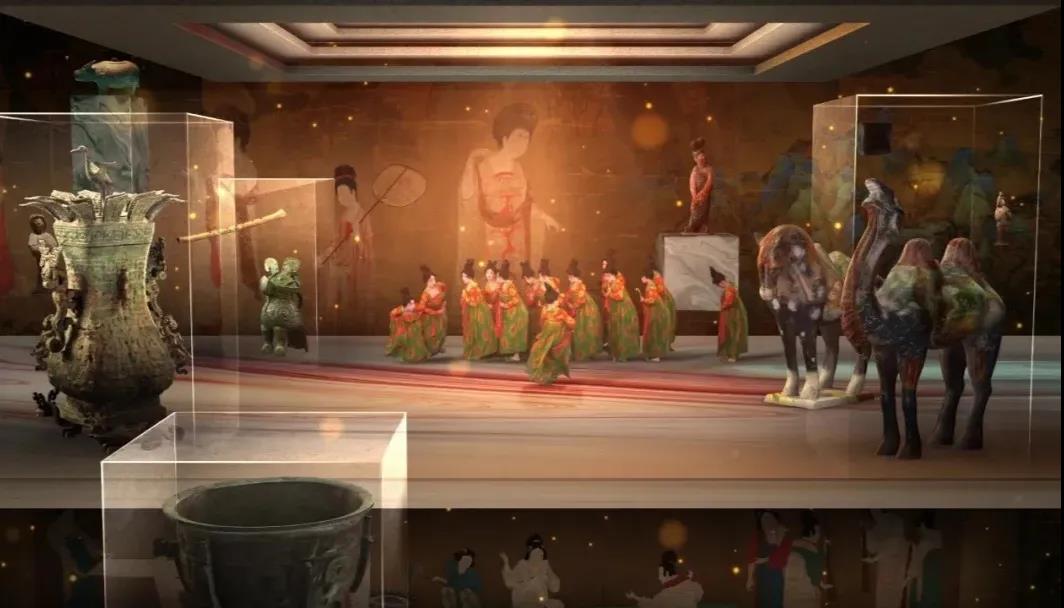
Weaken the entity space, highlight the virtual scene
The size of the entity space will affect the audience's immersive feeling. If the space volume is too small, the audience can feel the real environment, while the meaning immersion is that the viewer is completely immersed in the virtual environment. The methods to weaken the space itself are as follows:
Weaken ambient illumination. Make the visual focus of visitors within the light range of display information transmission. For example, teamlab processes the top surface of the display space into black, so that the audience's eyes can focus on the new media display on the wall and ground.
Enhance the softness of the spatial interface. As seen in Figure 5 below, firstly, the connection between the electronic screen and the projection in the angular space is not natural, which is not conducive to the authentic expression of virtual content; secondly, the curved interface reflects the light source evenly, and the colour and brightness of the picture are not affected, which is conducive to the authentic expression of the display content. Arc-shaped spatial forms have a lower spatial perception than broken linear spatial forms and are easier to create a sense of immersion.
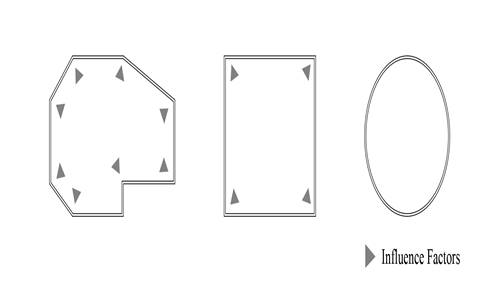
The exhibition space environment should match with the building environment. If the architectural design is built without considering the characteristics and needs of the display content, most of the exhibition space design will be separated from the architectural space design. Therefore, the design of exhibition space, exhibition content and exhibition route should be considered in advance in architectural design, so as to achieve the integration of architecture and space.
Weaken the entity space, highlight the virtual scene
In terms of space form, the traditional display design uses people's simple visual habits to reasonably combine the exhibits, auxiliary props and other elements in the display space to form a primary vertical or horizontal line form. At the same time, these forms have the functions of dividing, combining and limiting the space, so as to guide the audience's attention to the exhibits. There is no connection between the exhibition rooms, which are independent of each other. As seen in Figure 6 below, this paper analyses the three spatial forms and exhibition movement lines of "Fang Lijun Prints" exhibition space. As a regular exhibition, it satisfies the audience's view of individual works and groups of works, and the innovation of spatial structure also brings new ways for the audience to view the exhibition. But the design is output-oriented, featuring homogeneity and one dimension in the form of exhibition and exhibits, which only stimulates the audience's vision and presents a one-way and passive way of viewing. With the development of digital technology, the way of exhibition tends to be people-oriented design, which brings the interactive experience of psychological immersion to the audience. Interactive display design is deeply loved by the audience by virtue of the incomparable multimedia, interactivity and immersion of traditional display methods.
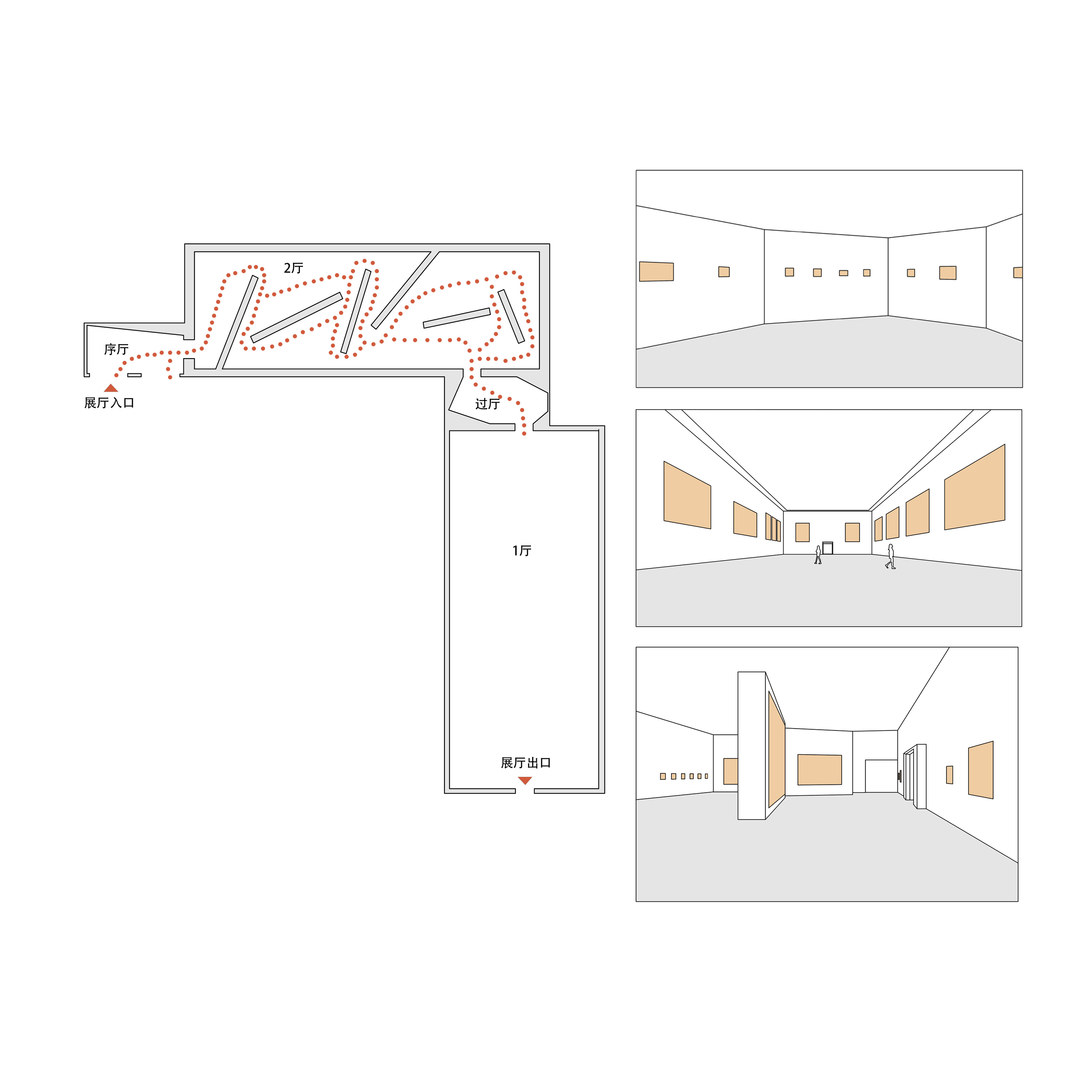
The space structure could be set with the freedom of movement to reflect the humanization. As seen in Figure 7 below, teamlab's exhibition " Universe of Water Particles in the Tank " retains the cylindrical space structure design of the oil tank without any rigid setting in the space. It uses multimedia technology to display on the wall and on the ground, blurring the boundaries between works of art, between works of Art and people, and between various established things, and immersing the audience deeply. It embodies a means for two-way communication and free viewing.
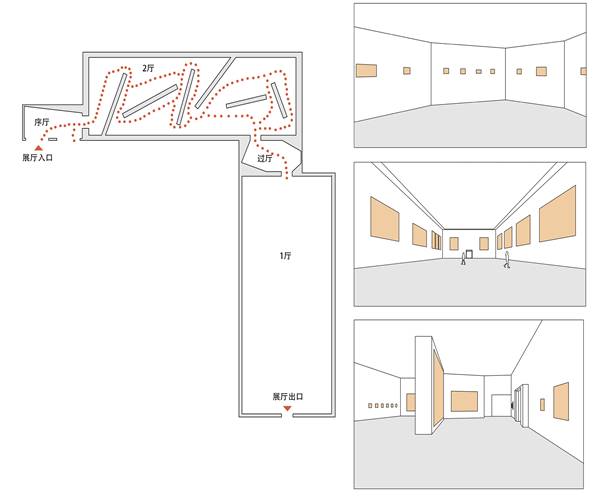
At the same time, according to the particularity of the design of immersive interactive experiential exhibition space, the following three points need to be paid attention to: 1) Most digital media exhibits need dark light environment, as well as special requirements for sound insulation and stereo sound in the sound environment. 2) The placement of relevant equipment should be considered, so as not to affect the aesthetics and functionality of the exhibition space. At the same time, the flexibility of equipment layout should also be considered. 3) Reserve maintenance space for large equipment. 4) Use advanced technology to design services for the disabled and vulnerable groups, and reserve barrier-free access in the exhibition space.
Conclusion
The development of technology has expanded the definition of media. The importance of "human" in communication advocated by media ecology provides a basis for digital display design. Digital media technology is an important force to promote cultural communication, and the design innovation of new media technology in the exhibition space not only meets the needs of the development of the times, but also improves the perception needs of people under the progress of the era. It is an inevitable trend to create an immersive display environment to meet the needs of humanity by applying new media technology. Scientific spirit and humanistic care are interactive relations that influence each other. The use of digital media is only an auxiliary means to open "immersive experience". Only the reasonable use of digital media to spread the display content with humanistic care, the theme reflecting cultural connotation and the innovative design concept can bring people spiritual pleasure.
Acknowledgments
Authors are responsible to list all funding sources in the Acknowledgments section. Please provide details of the sources of financial support for all authors, including grant numbers. For more information, please check the CrossRef’s Open Funder Registry.
References
Allam, Z., & Jones, D. S. (2020). Future (post-covid) digital, smart and sustainable cities in the wake of 6g: digital twins, immersive realities and new urban economies. Land Use Policy, 101, 105201.
Avatar 3D movie. (2021). Avatar 3D movie. https://mp.weixin.qq.com/s/-gbwYW-za4K7MXnXS28esw
Fischer, H. (2009). Digital shockwave. Chinese version, translated by Chun Huang. Tourism Education Press.
Karrie, S., & Wei, D. (2005). Communication as Culture: Proceedings of the Conference on Media and Society. Huaxia Publishing House.
Kenya, H. (2006). Design in Design. Chinese version, translated by E Zhu. Shandong People's Publishing House.
McLuhan, M., & Dao, K. H. (2000). Understanding Media: On the Extension of Man. The Commercial Press.
Meng, Y. F. (2020). "Cultural tourism integration" and "media integration" in the context of interactive art innovation research. Hundred Schools in Arts (02), 103-108.
Peng, S. (2012). Communication of new media art from the perspective of media environment...(eds.) Proceedings of the 6th National Symposium for Doctoral Students in Journalism and Communication, Communication University of China (pp. 643-652).
Shen, Y. S. (2009). Digital media society. Wuhan University Press.
Tang Palace Banquet. (2021). Tang Palace Banquet. https://mp.weixin.qq.com/s/IEgW7ST24V3yTFryJO5tzw
Universe of Water Particles. (2021). Universe of Water Particles Transcending Boundaries. https://walkwalkwalk-home.teamlab.art/
Walk, Walk, Walk Home. (2021). Walk, Walk, Walk Home. https://walkwalkwalk-home.teamlab.art/
Wang, Q., & Lei, Y. (2016). Minds on for the wise: rethinking the contemporary interactive exhibition. Museum Management and Curatorship, 31(4), 331-348.
Wen, G. L. (2007). Media Ecology: Evolution of Thought and Multi-dimensional Perspective. Chinese Journal of Journalism &communication, 11, 40.
Yan, W. (2020). Modern art exhibition space design strategy based on the theory of the immersion studies [Master's degree thesis]. Jilin Jianzhu University).
Ying, J. G. (2021). Application of virtual reality teaching method and artificial intelligence technology in digital media art creation. Ecological Informatics, 63, DOI:
Yu, M. S., & Shuo, J. M. (2019). From perceptual contact to immersive experience: the evolution of artistic reception paradigm from the perspective of media evolution. Journal of Southwest Jiaotong University (Social Science Edition), 4.
Copyright information

This work is licensed under a Creative Commons Attribution-NonCommercial-NoDerivatives 4.0 International License.
About this article
Publication Date
31 January 2022
Article Doi
eBook ISBN
978-1-80296-122-5
Publisher
European Publisher
Volume
123
Print ISBN (optional)
-
Edition Number
1st Edition
Pages
1-494
Subjects
Communication, Media, Disruptive Era, Digital Era, Media Technology
Cite this article as:
Xue, J., & Chen, R. (2022). Research on Immersive Digital Display Space From the Perspective of Media Ecology. In J. A. Wahab, H. Mustafa, & N. Ismail (Eds.), Rethinking Communication and Media Studies in the Disruptive Era, vol 123. European Proceedings of Social and Behavioural Sciences (pp. 219-230). European Publisher. https://doi.org/10.15405/epsbs.2022.01.02.18

